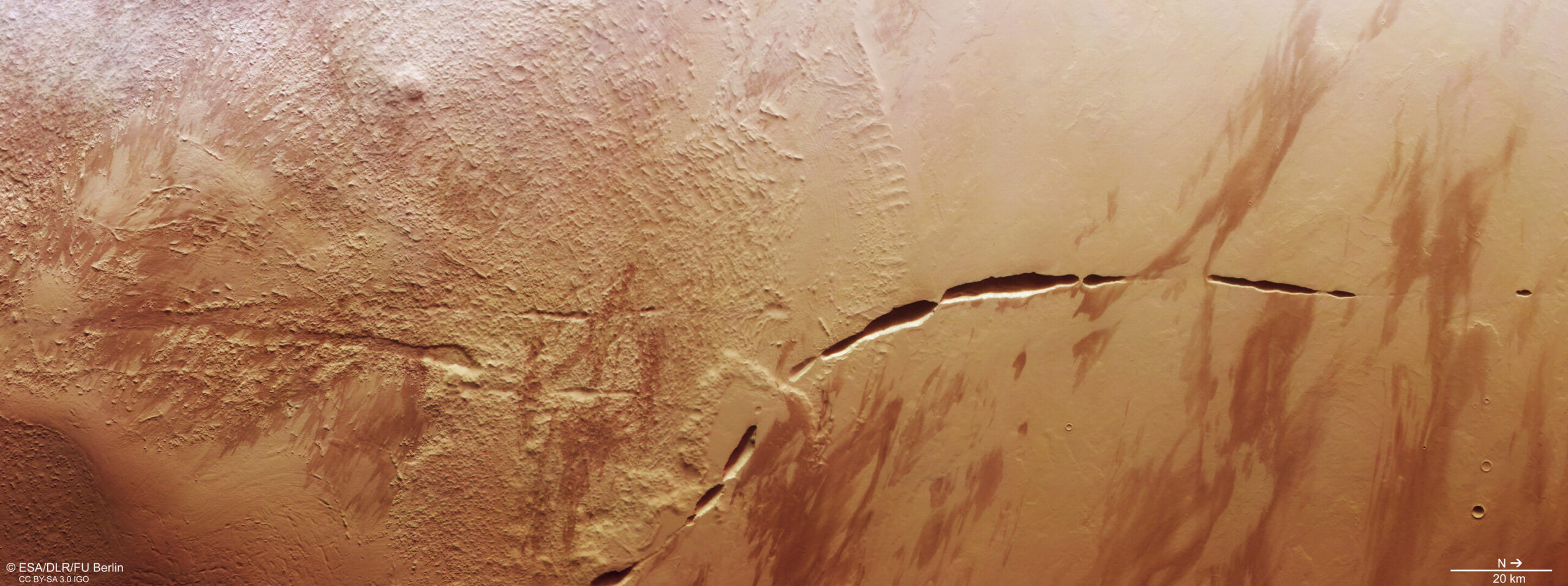03/07/2024
1089 views
10 I like this
This new image from ESA’s Mars Express reveals a fascinating feature: a dark, uneven scar cutting through the marbled ground at the foot of a giant volcano.
A broader view of Aganippe Fossa
This scar, known as Aganippe Fossa, is an irregular, approximately 600 km long feature known as a graben: a trench-like groove with steep walls on either side.
Aganippe Fossa slices through the lower flank of one of Mars’ largest volcanoes, Arsia Mons. Mars Express regularly observes Arsia Mons and its nearby companions in the Tharsis region, home to several of Mars’ giant volcanoes. This includes Olympus Mons, the tallest volcano in the solar system (visible on the context map accompanying this new image, as is Arsia Mons).
Arsia Mons itself is 435 km in diameter and rises more than 9 km above the surrounding plains. For context, the highest dormant volcano on Earth, Ojos del Salado on the border between Argentina and Chile, is less than 7 km high.
Seeping lava
We still don’t know how and when Aganippe Fossa formed, but it seems likely that it was formed when magma rose from beneath the colossal mass of the Tharsis volcanoes, stretching and tearing the Martian crust.
A winding scar on Mars. Click on the image to zoom in and see more detail.
In this image, Mars Express’s High Resolution Stereo Camera (HRSC) captures two different types of terrain: so-called hilly terrain, which consists of many irregularly shaped hills and valleys all close together, and lobate terrain, which consists of gently rolling cliffs and rocky scree.
Topography of Aganippe Fossa
These terrains are characteristic of Arsia Mons’ ring-shaped ‘halo’, a 100,000 square kilometre disk around the base of the volcano, possibly associated with ancient glaciers. Interestingly, this halo is only built up on the northwestern flank of the volcano, probably because of prevailing winds from the opposite direction that determine where ice has settled over time.
Windblown dust and sand have also shaped this patch of Mars, creating interesting zebra-like patterns on the right of the image as darker material is deposited on lighter ground (or vice versa!). The surface here also shows evidence of lava flows, dating back to the time when the volcano was active.
Exploring Mars
Mars Express has been orbiting the Red Planet since 2003. It is imaging the Martian surface, mapping its minerals, identifying the composition and circulation of its thin atmosphere, investigating the subsurface of the Martian crust, and studying how different phenomena interact in the Martian environment.
The spacecraft’s HRSC, responsible for these images, has revealed much about the diverse surface of Mars over the past 20 years. The images reveal everything from wind-sculpted ridges and grooves to sinkholes on the flanks of colossal volcanoes to impact craters, tectonic fractures, riverbeds and ancient lava pools. The mission has been enormously productive throughout its lifetime, delivering a far more complete and precise understanding of our planetary neighbor than ever before.
Aganippe Fossa in 3D
The Mars Express High Resolution Stereo Camera (HRSC) was developed and is operated by the German Aerospace Center (Deutsches Zentrum führen).r Aerospace; DLR).
